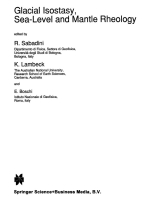Добрый день, Коллеги. Важное сообщение, просьба принять участие. Музей Ферсмана ищет помощь для реставрационных работ в помещении. Подробности по ссылке
Glacial isostasy, sea-level and mantle rheology / Ледниковая изостазия, уровень моря и реология мантии
Viscosity is one of the important material properties of the Earth, controlling tectonic and dynamic processes such as mantle convection, isostasy, and glacial rebound. Yet it remains a poorly resolved parameter and basic questions such as whether the planet's response to loading is linear or non-linear, or what are its depth and lateral variations remain uncertain. Part of the answer to such questions lies in laboratory observations of the rheology of terrestrial materials. But the extrapolation of such measurements from the laboratory environment to the geological environment is a hazardous and vexing undertaking, for neither the time scales nor the strain rates characterizing the geological processes can be reproduced in the laboratory. General rules for this extrapolation are that if deformation is observed in the laboratory at a particular temperature, deformation in geological environments will occur at a much reduced temperature, and that if at laboratory strain rates a particular deformation mechanism dominates over all others, the relative importance of possible mechanisms may be quite different at the geologically encountered strain rates. Hence experimental results are little more than guidelines as to how the Earth may respond to forces on long time scales. Answers to the question as to what is the appropriate responses of the Earth to forces acting upon it therefore rest largely upon the analysis of these very processes, using a variety of geophysical, geochemical and geological observations of the action and the reaction. This also is a high risk undertaking, with the danger being that the deduced response is only as good as any assumptions made about the forces that lead to that deformation. <...>




